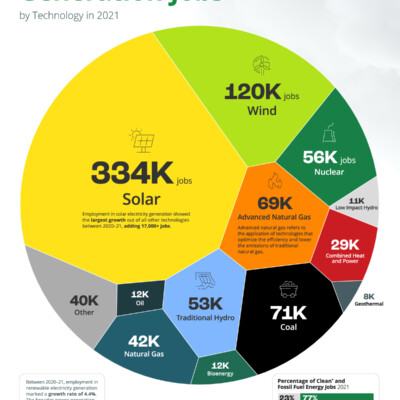By Selin Oğuz
Visualizing U.S. Electricity Generation Jobs by Technology
In 2021, 857,579 people were employed in the U.S. electricity generation sector.
To explore the distribution of this workforce, the above graphic by the National Public Utilities Council breaks down the number of jobs for each electricity generation technology using the U.S. Department of Energy’s Energy and Employment Report.
An Evolving Employment Landscape
The employment landscape within the U.S. electricity generation sector is continually evolving, driven by technological shifts, growing urgency towards decarbonization, and new policy initiatives.
Here are some interesting trends seen in 2021.
1. Solar Leads the Way with Significant Job Growth
The solar energy sector emerged as a shining star in 2021, witnessing substantial job growth compared to other electricity generation technologies. With a total of 333,887 jobs, solar not only topped the chart but also experienced a notable increase of over 17,000 jobs from the previous year.
This surge in solar jobs can be attributed to several factors, including advancements in technology, falling costs, and increased adoption of renewable energy sources across the country.
2. Advanced Natural Gas Employs More People Than Traditional
While renewable energy sources gained traction, advanced natural gas also played a significant role in the U.S. electricity generation sector with 69,113 jobs.
Advanced natural gas refers to the application of technologies that optimize efficiency and reduce the emissions associated with traditional natural gas.
As the fourth biggest employer on the list, advanced natural gas employed more people than traditional natural gas in 2021.
3. Renewable Energy Sector Outpaces Broader Sector Growth
Between 2020 and 2021, the renewable electricity generation sector experienced a robust growth rate of 4.4% in employment, outpacing the broader power generation sector’s growth rate of 2.9%.
The employment figures highlight the potential for continued job creation within the renewable sector as the transition to cleaner energy sources gains further momentum.
Getting Over the Workforce Development Hurdle
The employment figures in the U.S. electricity generation sector demonstrate promising growth in clean energy jobs. With that said, rapid decarbonization of the sector may still require a level of workforce development that hasn’t yet been seen in the United States.
As electric utilities and the nation at large strive to achieve their ambitious net-zero goals, investing more in workforce development can be an integral piece of the puzzle, specifically to help individuals transition smoothly from fossil fuel jobs to those in clean generation.
By addressing this challenge, the U.S. can ensure a well-prepared workforce that will drive the transition to a sustainable and net-zero future.
Read full article here.


